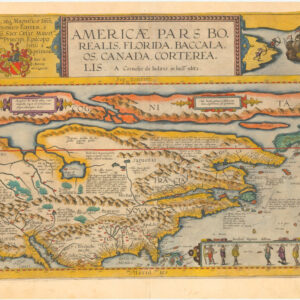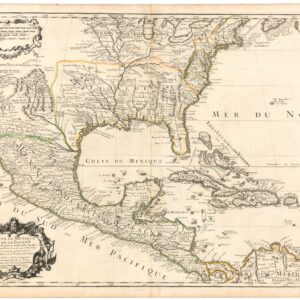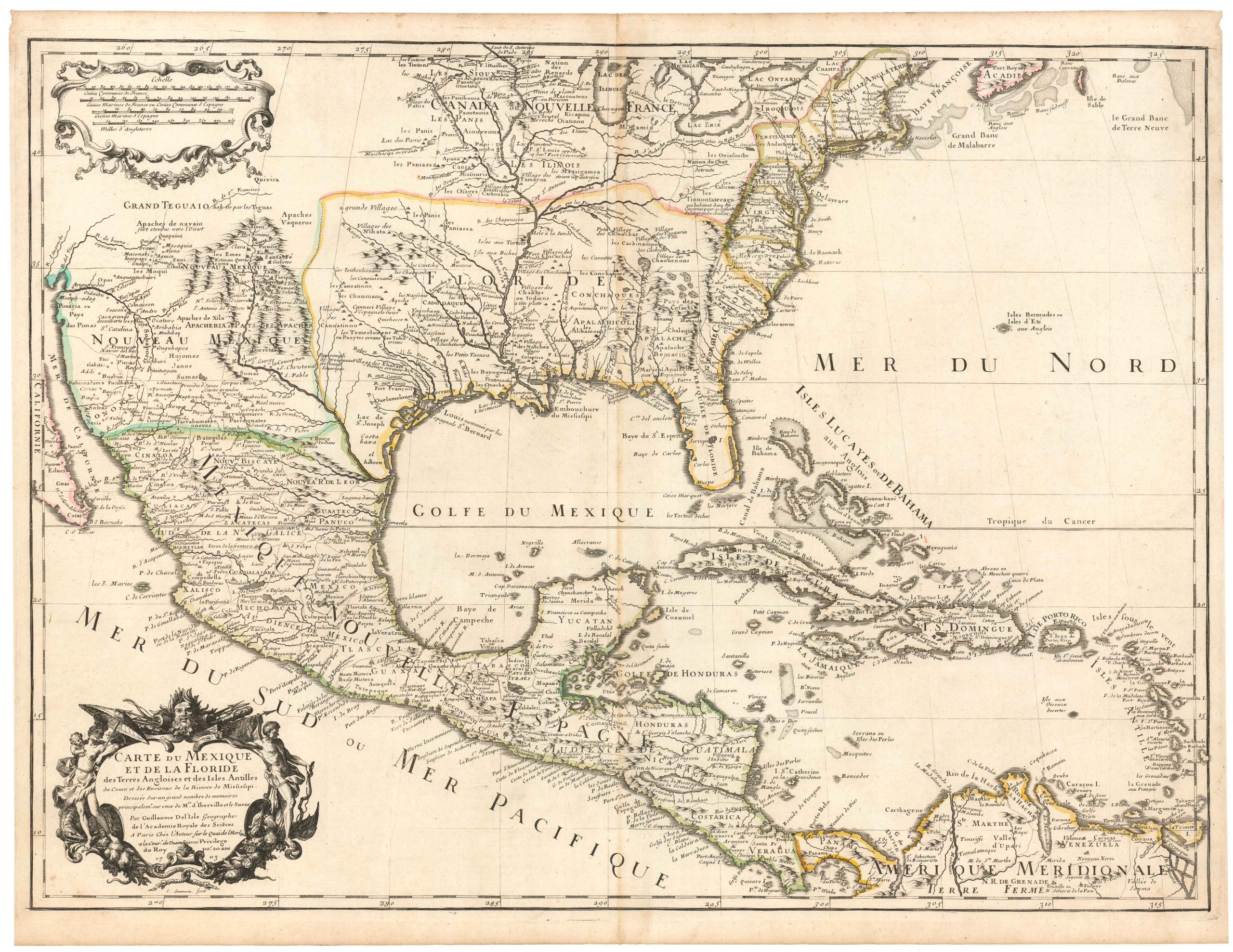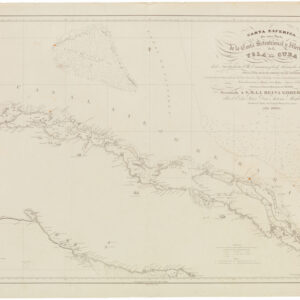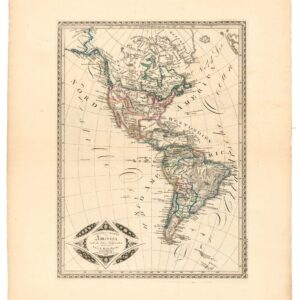A.S. Woodburn’s rare 1885 map of Ottawa: one of the earliest acquirable large-scale city plans of Canada’s national capital.
Map of the City of Ottawa, Published by A.S. Woodburn. Ottawa.
Out of stock
Description
One of the most detailed and refined plans of the Canadian capital ever produced!
This monumental 1885 plan is a detailed and full depiction of the Canadian capital, less than fifty years after its foundation, and only fifteen years before a catastrophe would destroy almost a quarter of the city. Not only is it one of the earliest large-format maps of Ottawa that one can acquire on the open market, but it is also among the rarest and most spectacular charts ever produced of this metropolis. Even though Woodburn was a publisher himself, the map was printed as a color lithograph on a large format sheet (50 x 33 inches or 127 x 84 cm) by George Bishop & Co. in Montreal. It was subsequently dissected and laid on linen, making Neatline’s copy as originally issued.
Laid out in an almost perfect grid, the map subdivides Ottawa into its five respective wards by means of color coding. There is one notable addition to this, but to this we shall return in a moment. The town itself is rendered in extraordinary detail, allowing viewers to identify and locate everything from individual streets and public buildings (e.g. the town hall, schools, the jailhouse), to churches, parks, bridges, and town squares. In some cases, property delineations and ownership information is even included, making it both a modern document, as well as one anchored in an intimate knowledge of the city. And it is not left at that: important locations for visitors, such as hotels, railway stations, and railroad lines also figure prominently on the map. Along the river fronts, wharves and canals are clearly shown and remind us how important the river was, and continues to be, for Ottawa’s inhabitants.
An important element that might help explain how up-to-date information was packed into this map is the printed signature and note underneath the title cartouche. This reads:”Examined and approved by Robert Surtees, C.E., 1st January 1885”. The note is interesting in light of all the architectural information included on the map, for Robert Surtees was one of Ottawa’s earliest architects and the designer of many of her first monumental buildings, including: the Wallis House and Carleton County Courthouse. It is not unlikely that he would have reviewed and perhaps even provided Woodhouse with fresh information prior to the map’s publication.
Across the river, there are references to the sister settlement of Hull, and in the upper right corner of the map, we find the Village of New Edinburgh in the Rideau Ward. This is fully delineated, properly labeled, and seemingly constitutes part of the city. New Edinburgh was founded in the early days of the town by the scotsman Thomas McKay, who also built the locking system on the Rideau Canal within Ottawa proper. McKay bought the land in 1829 and soon began building a settlement there, which he named after his hometown. The streets of the village were all named after his family (as can be seen in the map). Prior to McKay’s purchase of the land, it had been primarily industrial, with several lumber mills drawing power from the flow of the rivers. These helped McKay convert the area quickly by securing and regulating the water flow to his new township and having the infrastructure to process both timber and agricultural yields.
Interestingly, New Edinburgh was originally a part of the Gloucester Township despite its proximity to Ottawa. In 1866, a special act in parliament nevertheless granted New Edinburgh the right to be a separate and distinct village in its own right. This would still have been the case in 1885 when this map was published. Yet one almost senses how Ottawa had her eye on New Edinburgh, incorporating it more or less seamlessly into the new and official plan of the city. These ambitions manifested themselves more blatantly only two years later, when New Edinburgh was forcefully annexed by the City of Ottawa.
The New Edinburgh affair is just one of many exciting stories embedded in this map. The beautiful and very accurate rendition of the Ottawa River and its many riverine islands tells another. One must appreciate the degree of detail lent to charting its course properly. This dedication to accurately depicting waterways reflects just how important the rivers were for the development of a large settlement here.
The city is essentially located on a promontory created by the confluence of the Ottawa River and the somewhat smaller Rideau River, shown along the eastern edge of the map. In addition to formally separating the provinces of Quebec and Ontario, the Ottawa River provided resources and water for irrigation. More importantly perhaps, it constituted the most important means of transporting goods — especially timber — across great distances to larger ports and commercial hubs. Nothing demonstrates this reliance on the waterways more clearly than the Rideau Canal.
This was an enormous canal project in which a 202 km watercourse was constructed from the Ottawa River to the northern shores of Lake Ontario. It was dredged out by soldiers and laborers, who dug between two existing rivers (the Rideau and the Cataraqui) and a number of lakes to create a coherent and navigable waterway that constituted a new interior route between Ottawa and Kingston. The canal was built over the course of six years, between 1826 and 1832, and was initially meant as a defensive measure following the War of 1812 (see context section below). It nevertheless quickly became a vital mercantile lifeline between the Canadian capital and the financial centers of Toronto and Montreal.
In the upper right of the map, we see a small section of the Rideau River where it meets the Ottawa, but within the township itself, the new waterway consisted of a large canal extending south from the area of Parliament Hill. This linked to a calmer section of the Rideau River further south (beyond the scope of our map).
Context is everything
The area around the confluence of the Ottawa and Rideau Rivers was first occupied by settlers around the year 1800, when Philemon Wright of Massachusetts brought six families and 25 laborers to establish a new agricultural settlement there. Being a heavily wooded area along the banks of a major river, large swathes were cleared and the timber prepared for sale. In doing so, Wright discovered that it was possible to transport the excess timber to Montreal via the river, and within a generation or two, the settlement was booming from the timber trade. This brought significant wealth to the region, as well as many new people looking to for economic opportunity.
Even though the American British War of 1812 saw the borders between the involved parties largely unchanged, the US-Canada frontier had seen a lot of heavy fighting, and towards the end of the war the British sent a very large contingent of troops there in order to push across the border. While this never actually happened, the conflict made a deep impression on the local settlers and inhabitants, who from this point on remained extremely cautious of both American and British geo-political interests. After the war, the Canadian government instigated a successful emigration scheme aimed at drawing both Catholic and Protestant Irish to settle in the areas. Complimented by French Canadians coming in from Quebec, this saw the population of the Ottawa region grow significantly during the 1820s. Many of these emigrants were the same people involved in the construction of the above mentioned Rideau Canal.
The canal was initially conceived as means of securing trade and communication between the major cities of Montreal and Toronto. These were already directly connected by Lake Ontario and the St Lawrence River. The problem was that the section of the St Lawrence River between Lake Ontario and Montreal bordered New York State on the east. In light of the heavy fighting between Americans and British Canadians during the war, most Canadians were keen to create a secure route between the two important centers; one that could not be subjected to surprise attacks, illegal confiscations, or sudden tolls.
Expanding the Rideau and Cataraqui Rivers to form a canal that ran south from the Ottawa promontory to reach Lake Ontario was a brilliant, albeit somewhat megalomaniac idea. In doing so, the entire route lay well within the Canadian borders and could thus not be as easily usurped in a potential future conflict. For the same reason, maps of the canal remained top secret for a long time during its construction. Once completed, however, the canal added further to both the population and the economic growth of the region. More importantly perhaps, it stimulated the growth of a new settlement based on the infrastructure and housing originally meant for the canal labour force.
Construction of the Rideau Canal was spearheaded by Colonel John By. He decided that the most efficient and discrete way to establish this alternative water course would be to progress from north to south. Consequently, at the outset of the project in 1826, one of the first orders from Colonel By was the construction of a large barracks for the soldiers and laborers engaged in this great undertaking. The site of these barracks would be right next to where Colonel By envisioned he would begin digging the first stretch of canal. This canal would circumvent the sometimes violent confluence of the Ottawa and Rideau Rivers slightly further north.

As the scope of the project grew, so did the number of people involved, and consequently the capacity for housing and feeding had to be upgraded as well. Gradually, a townsite was laid out around the barracks to accommodate to the growing number of families and businesses attracted to the large construction project. The makeshift township soon became known as Bytown, after Colonel By, and would in the next few decades become the heart of Canada’s newest urban centre. Once construction of the canal was complete, the barracks were upgraded to more official public buildings.
While its beginnings were humble, the new settlement soon became an important mercantile hub, especially for the timber trade. It was extremely well connected to both Montreal and Toronto, and in 1855 it received the formal status of a city and was renamed Ottawa. Only two years later, Queen Victoria recognized the ideal strategic location of this town and formally selected it as the permanent capital for the Province of Canada, despite its still diminutive size. While completion of the canal had ensured that Ottawa would continue to grow as a hub for interior trade, her new position as the political center of Canada meant that she became attractive for a whole different set of reasons. With the appointment, Ottawa saw an influx of an entirely new class of people (bureaucrats, clerks, politicians, lobbyists etc.).
As capital, Ottawa would of course need to be equipped with a Parliament building and where better to construct this important symbol of national pride and dignity than on the site of Colonel By’s original barracks. This centrality is clearly visible in our wonderful map, just as the constructed section of the canal runs as a spinal column through the township. To the west of this canal, in what became known as Uppertown, we find the wealthier domiciles as well as the public buildings associated with government. Across the canal, in what was now a separate promontory known as Lowertown, lived the majority of the population. Its position and legitimacy now fully underscored, Ottawa soon began another period of intense growth, which saw habitation move far beyond the constraints of the original promontory.
In 1900, fifteen years after this map was compiled and published, the Great Hull-Ottawa fire raged and burnt half the sister settlement of Hull to the ground. Fierce winds allowed the fire to spread across the river and into Ottawa, which burned for days and saw almost a quarter of the city destroyed. The conflagration first hit the wharf islands of Chaudiere and Victoria, before spreading south into Lebreton Flats. By the time it was finally under control, the fires had reached as far inland as Booth Street and Dow’s Lake, in what today is Commissioners Park.
Census
This map is very rare. There are only two examples of this map listed by OCLC (Canadian National Archives and York University).
Cartographer(s):
A. S. Woodburn was a printer, publisher and bookbinder based in Ottawa, Canada. He published more than 35 books by different authors. As a testimony to his social position and engagements, we note that Woodburn spearheaded the Ottawa Free Press and was the driving force behind Ottawa’s first City Directories. When his famous Map of the City fo Ottawa was published in 1885, Woodburn was one of the city’s leading printers.
Condition Description
Folding map sectioned on original linen. Original color. Some wear, espcially at folds. Excellent, clean, bright.
References
